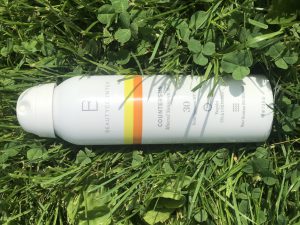Sunscreen is meant to protect us..but it may be doing the opposite. And it may be harming the environment at the same time.
Oxybenzone. This is the name of the chemical found in many commonly used sunscreens that is getting a lot of the blame for the death of coral reefs around the world. It is often talked about how global warming is contributing to the loss of the vibrant coloring of coral reefs, with some areas of The Great Barrier Reef losing up to 83% percent of its coral. But global warming is not the sole contributor to the death of this magnificent reef. Research on oxybenzone shows that it disrupts reproduction and growth in coral. According to the report Sunscreen Pollution published on MarineSafe.org by Craig Downs, Ph.D, this chemical leaves young coral deformed and unable to thrive. Downs explains how sunscreen pollution prevents “the recovery and restoration of already degraded reefs,” and says that the most alarming of his findings determined that “oxybenzone also acts as an endocrine disruptor, causing the coral larvae to inappropriately encase itself in its own stony skeleton — at a time in its development when it should not even have a skeleton.” Research is also beginning to show how sunscreen pollution effects fish, sea urchins, algae and mammals as well.
If oxybenzone effects marine life in such tragic ways, it makes one wonder its effects on humans.
According to The Environmental Working Group’s (EWG) Skin Deep Database, which “creates online profiles for cosmetics and personal care products and their potential hazards and health concerns,” on a scale of one to ten, with one being the least hazardous and ten the most, oxybenzone has a score of eight! It is known to cause photoallergic reactions, meaning when exposed to ultraviolet rays (aka the sun), its structure changes and it is then seen as an invader to the immune system. Just like everything else we put on our skin, oxybenzone is absorbed into our bodies. EWG also warns that it is a bioaccumulative chemical, has negative effects on cells and may even lead to implications in cardiovascular disease.
But oxybenzone is not the only cause for health concern in sunscreens.
Some of the products from the most common sun care lines, such as Coppertone and Banana Boat, rate anywhere form a two to a ten on EWG’s scale, with average ratings of seven! The main concerns in these products are irritation, bioaccumulation, organ system toxicity, endocrine disruption and (although a low concern) even cancer! EWG also states that the data available on these brands is limited, meaning they may not disclose some of the ingredients used in their products.
So how can we protect the environment, while safely protecting ourselves from the sun?

Fortunately, many companies are on the same side as Downs and the EWG and are coming out with with safer sunscreens. Beauty Counter is one company that has launched a safe-for-you-and-the-environment suncare line. The line consists of three products: a mist, a lotion and a stick (SPF 30). Their Countersun Collection protects against UVA, UVB and blue light. The mist sunscreen uses a bag-on-valve actuator system rather than aerosol technology and all three products are reef-friendly. Aside from banning oxybenzone, Beauty Counter also bans octinoxate which has been known to effect coral reefs the same as oxybenzone. And for our safety, Beauty Counter’s sunscreens are mineral based, using zine oxide or titanium dioxide, rather than using chemical filters.
